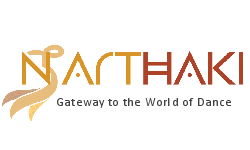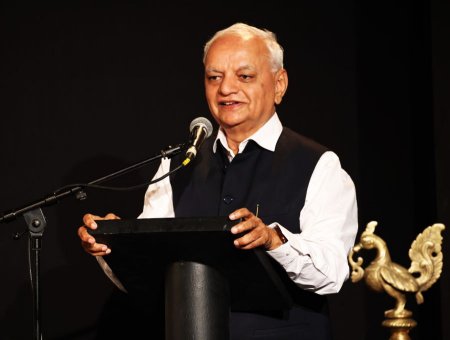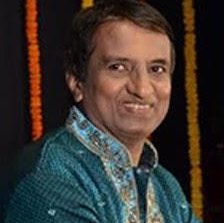
|   |

|   |
Inclusion of Bhagavad Gita and Natya Shastra in the UNESCO Register - Vijay Shanker e-mail: vijaydance@gmail.com May 7, 2025 On the occasion of the inclusion of the Bhagavad Gita and Bharat Muni's Natya Shastra in the UNESCO Memory of the World Register, Ministry of Culture and Sangeet Natak Akademi organised a panel discussion on Bhagavad Gita and Natya Shastra - Cultural Treasure of Humanity, at the Meghdoot theatre in New Delhi on Friday April 25th. The panellists were Dr Padma Subrahmanyam, Dr Sandhya Purecha, Dr Bharat Gupt, Dr Bhagyesh Jha and Guru Piyal Bhattacharya.  Dr. Sandhya Purecha, Dr. Bharat Gupt, Raju Das Secretary of the Sangeet Natak Akademi, Raju Das welcomed the gathering and briefly interpreted the significance of the seminar, while announcer Vijay Singh introduced the speakers. Dr Padma Subrahmanyam could not attend the seminar due to prior commitments but in the video recording stated that the Bhagavad Gita is acknowledged as the eternal wisdom applauded globally and the Natya Shastra is known for its aestheticism of the performing arts and Natya Veda was evolved during the Tretha Yuga as Bharata was a contemporary of Valmiki. She further spoke about her extensive research of the 108 Karanas and how she follows the Marga Paddati of the Natya Shastra. Dr Padma referred to the Nataraja Temple in Satara which is similar to the Chidambaram temple and also ascertained the point that the basic purpose of the performing arts is not just education but also elevation. She thanked SNA for having invited her to talk on such an important occasion. Dr Sandhya Purecha rendered a brilliant speech in impeccable Hindi pertaining to the significance of both Bhagavad Gita and Natya Shastra. She said that the Natya Shastra was written by Bharata Muni who was a Rishi, hence all artists are like Rishis as the basic purpose of the performing arts is not just entertainment but education and elevation that leads the audience to a supreme level of consciousness. The Natya Shastra has 36 chapters with 6,000 shlokas. "Lok Shikshanam, Lok Vedasya Rupam" refers to the dialogue with Arjuna which is based on "Atma", "Kartavya" and "Moksham". Further Sandhya referred to Chanakya who said that "Shastra padna chod dete hain, woh samapth ho jata hain" (the person who fails to study the Shastra, does not exist, as he fails to understand the significance of life). Pertaining to Lakshana and the Prayog Shastra is the theory of practise. What is interpreted in the text and how to bring into practise, Akruthi, Chestha and Katha Vasthu; to understand every part in order to create a complete whole. Chapters 8 to 13 refers to Angika Abhinaya. Ved Adaya refers to mind, intellect and character of human life which is based on Dharma, Artha, Kama and Moksha. By and large, Natya Shastra is a fine combination of Shastra, Sampradaya, Samskara, based on the technicalities of the text. Furthermore, it depends on the dancer or actor as to how the paddhati is executed, maintaining the aesthetic quality, while forming a fine combination of music, dance, drama, sahitya and other aspects pertaining to the character or 'patra' that is personified.  Dr Bhagyesh Jha Sanskrit scholar Dr Bhagyesh Jha started his speech in Sanskrit pertaining to the significance of the seminar with relation to the inclusion of the Natya Shastra and Bhagavad Gita in the UNESCO register that really thrilled the audience. He said he could continue to talk in Sanskrit but that would not serve the purpose as many would not understand. The basic message of the Bhagavad Gita is "Karmanyadhirasthe ma faleshu kadachin" (Do your duty, do not wait for the fruits or the result). He stated that when a youngster seeks a job, the first thing that he would want to know is, what is the salary? Without realising that it is the complete involvement in the job which is the necessary quality that would eventually yield results, but each one considers himself to be "Aham Brahma Asmi" (I am Lord Brahma). At such a junction, God also cannot help you. It is important to be involved and not attached. The Bhagavad Gita is an education that transforms everyone, teaching how one can get attached and detached at the same time, that forms the core of spirituality. Theatre personality and director of National School of Drama, Dr Bharat Gupt said, "Ancient theatre was referred to as Sanskrit theatre, which is wrong as theatre was multilingual due to regional differences. According to Natya Shastra - "Natya lokan thirthanam". Theatre was of three types, namely Uttama, Madhyama and Adayam, differentiated according to the type of audience. Originally theatre was Dasha Rupakam, ten types of theatre." Furthermore, Dr Gupt also revealed that the process of getting the Natya Shastra registered with UNESCO was not an easy task as the original text is in Sanskrit, which is not understood by them, hence translated scripts were also submitted. Guru Piyal Bhattacharya, known for Marga Natya based on the Natya Shastra said, "Where Movement becomes Mantra - "Vritti" and "Pravritti". In the 1st chapter of the Natya Shastra, Bharata Muni mentions three Vrittis, as present in his initial natya production. The commentator Acharya Abhinavagupta explains vritti as 'vyapara vachaka pada', vyapara means activity that makes Bharati -vocal activity, arabatti - rigorous physical activity and sattvati - activity of the mind. Now Natya being 'lokaanukarna' follows the natural order of human activity. First it is conceived with the cittakasa of the manah, followed by the manifestation of the same bhavana in bhutakasa. However, one aspect remains constant; all these necessitate hurls on the citta vritti and citta vritti is always directed towards any object. Pravrittis are brought in, just as we get to see various dimensions of the 'accara' associated with the same mantra across provinces, for all serving as a platform to connect to the 'caitanya' of that mantra. The Natya Shastra too lays a favourable array of pravriiti to create a fitting vessel to lead to the intended sublime experience of 'rasa', and this is the 'tatva' of the dynamics of vritti and pravritti, embedded within the encoded heritage of the Natya Shastra." Undoubtedly, it is a matter of great pride for India and Indians, as both Natya Shastra and Bhagavad Gita get global attention and recognition.  Vijay Shankar is a Kuchipudi and Kathakali exponent, teacher, bilingual journalist, arts critic and actor. |